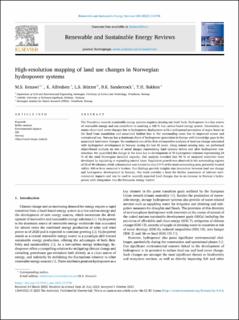| dc.contributor.author | Kenawi, Mahmoud Saber Refaei | |
| dc.contributor.author | Alfredsen, Knut Tore | |
| dc.contributor.author | Stürzer, LS | |
| dc.contributor.author | Sandercock, Brett Kevin | |
| dc.contributor.author | Bakken, Tor Haakon | |
| dc.date.accessioned | 2023-10-18T08:56:49Z | |
| dc.date.available | 2023-10-18T08:56:49Z | |
| dc.date.created | 2023-10-16T18:08:36Z | |
| dc.date.issued | 2023 | |
| dc.identifier.issn | 1364-0321 | |
| dc.identifier.uri | https://hdl.handle.net/11250/3097211 | |
| dc.description.abstract | The Transition towards sustainable energy systems requires phasing out fossil fuels. Hydropower is a key source of renewable energy and can contribute to reaching a 100 % low carbon-based energy system. Uncertainty remains about land cover changes due to hydropower deployment with a widespread perception of major losses in the land from inundation and associated habitat loss in the surrounding areas due to improved access and recreational use. Norway has a dominant share of hydropower generation in Europe with knowledge gaps in the associated land cover changes. We conducted one of the first retrospective analyses of land use change associated with hydropower development in Norway during the last 80 years. Using remote sensing data, we performed object-based analysis on sets of aerial images representing land systems before and after hydropower construction. We quantified the change in the land due to development of 40 hydropower schemes representing 24 % of the total Norwegian installed capacity. Our analysis revealed that 88 % of analyzed reservoirs were developed by regulating or expanding natural lakes. Vegetation growth was observed in the surrounding regions of 22 of 40 schemes, while urbanization was limited to only 0.9 % of the total surrounding area, primarily located within 400 m from reservoir's borders. Our findings provide insights into interaction between land use change and hydropower development in Norway. Our work provides a basis for further assessment of relevant environmental impacts and can be used to quantify expected land changes due to an increase in Norway's hydropower with integration into the European energy market. | en_US |
| dc.language.iso | eng | en_US |
| dc.publisher | Elsevier | en_US |
| dc.rights | Navngivelse 4.0 Internasjonal | * |
| dc.rights.uri | http://creativecommons.org/licenses/by/4.0/deed.no | * |
| dc.title | High-resolution mapping of land use changes in Norwegian hydropower systems | en_US |
| dc.title.alternative | High-resolution mapping of land use changes in Norwegian hydropower systems | en_US |
| dc.type | Peer reviewed | en_US |
| dc.type | Journal article | en_US |
| dc.description.version | publishedVersion | en_US |
| dc.source.volume | 188 | en_US |
| dc.source.journal | Renewable and Sustainable Energy Reviews | en_US |
| dc.identifier.doi | 10.1016/j.rser.2023.113798 | |
| dc.identifier.cristin | 2185254 | |
| cristin.ispublished | true | |
| cristin.fulltext | original | |
| cristin.qualitycode | 1 | |

